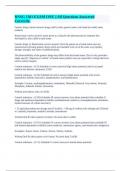RNSG 1301 EXAM ONE || All Questions Answered
Correctly.
Generic drugs correct answers drugs sold by their generic name; not brand (or trade) name
products
Brand name correct answers name given to a drug by the pharmaceutical company that
developed it; also called a trade name
Genetic drugs vs Brand name correct answers Once the patent on a brand name runs out
manufactures develop genetic drugs which are intended work on in the same way (quality,
dosage, strength, and route of administration).
The bioavailability of the generic drugs may differ from the brand name. This is why providers
might specify "dispense as written" so brand name product may use especially in drugs that have
narrow safety margins.
Control substance - (C-I) Schedule I correct answers High abuse potential and no accepted
medical use (heroin, marijuana, LSD)
Control substance - (C-II) Schedule II correct answers High abuse potential with severe
dependence liability (narcotics, amphetamines, and barbiturates)
Example: Cocaine, methamphetamines, methadone, Dilaudid, Demerol, Oxycodone, Fentanyl,
Morphine, Adderall, Ritalin, Dexedrine.
Written prescription only, no refills
Control substance - (C-III) Schedule III correct answers Less abuse potential than schedule II
drugs and moderate dependence liability (nonbarbiturate sedatives, nonamphetamine stimulants,
limited amounts of certain narcotics)
< 15 mg hydrocodone per dosage unit (Vicodin) ; < 90 mg of codeine p3er dosage unit (Tylenol
w/ codeine); ketamine; anabolic steroids; testosterone
Written/Oral Rx that expired w/n 6mos. No more than 5 refills.
Control substance - (C-IV) Schedule IV correct answers Less abuse potential than schedule III
and limited dependence liability (some sedatives, antianxiety agents, and nonnarcotic analgesics)
Examples: Xanax, Soma, Valium, Ativan, Talwin, Ambien
Written/Oral Rx that expires w/n 6 mons. No more than 5 refills.
Control substance - (C-V) Schedule V correct answers Limited abuse potential
, Cough suppressants < 200 mg codeine/100 mL (Robitussin AC), Lomotil, Motofen, Lyrica,
Parepectolin
Written Rx or OTC; must be 18 yo, ID must be showed, and dispensing must be recorded
The Controlled Substances Act of 1970 correct answers Control over the coding of drugs and the
enforcement of these codes to the FDA and the Drug Enforcement Agency (DEA), a part of the
U.S. Department of Justice.
Pregnancy category A correct answers Adequate studies in pregnant women have not
demonstrated a risk to the fetus in the first trimester of pregnancy, and there is no evidence of
risk in later trimesters.
Pregnancy category B correct answers Animal studies have not demonstrated a risk to the fetus
but there are no adequate studies in pregnant women.
Pregnancy category C correct answers Animal studies have shown an adverse effect on the fetus
but there are no adequate studies in humans; the benefits from the use of the drug in pregnant
women may be acceptable despite its potential risks, or there are no animal reproduction studies
and no adequate studies in humans.
Pregnancy category D correct answers There is evidence of human fetal risk, but the potential
benefits from the use of the drug in pregnant women may be acceptable despite its potential
risks.
Pregnancy category X correct answers Studies in animals or humans demonstrate fetal
abnormalities or adverse reaction; reports indicate evidence of fetal risk. The risk of use in a
pregnant woman clearly outweighs any possible benefit.
Pharmacotherapeutics correct answers clinical pharmacology—the branch of pharmacology that
deals with drugs; chemicals that are used in medicine for the treatment, prevention, and diagnosis
of disease in humans
Pharmacodynamics correct answers The process by which a medication works on the body.
The study of the interactions between the chemical components of living systems and the foreign
chemicals, including drugs, that enter living organisms; the way a drug affects a body.
Pharmacokinetics correct answers the way the body deals with a drug, including absorption,
distribution, biotransformation (metabolism), and excretion
Factors affecting drug effects correct answers - Weight
- Age
- Gender
- Physiological factors (diurnal rhythm, electrolyte balance, acid-base balance, hydration)




